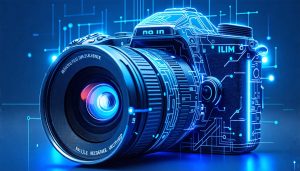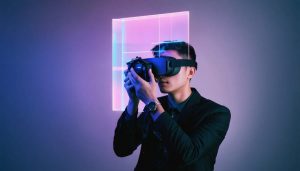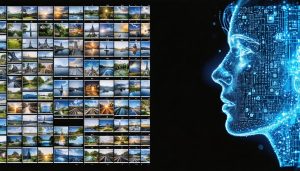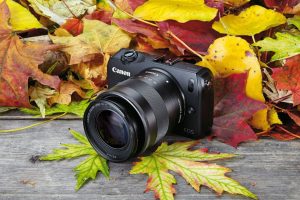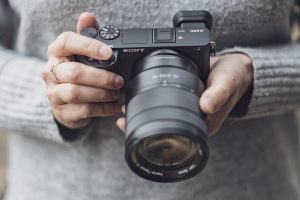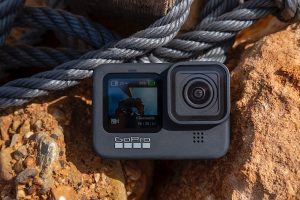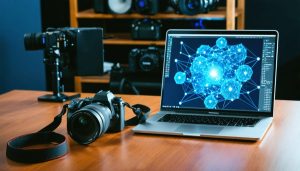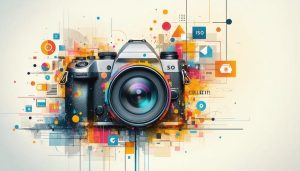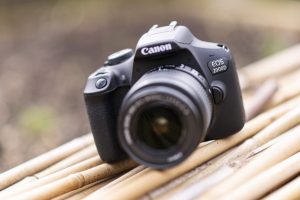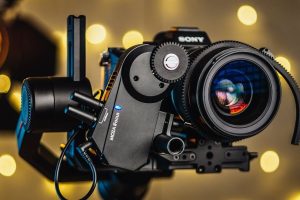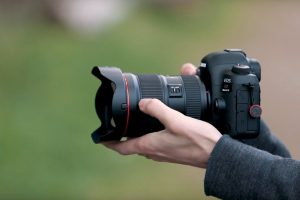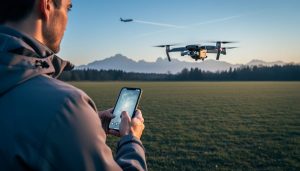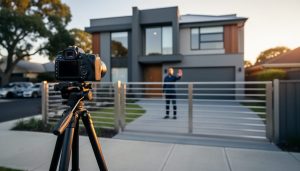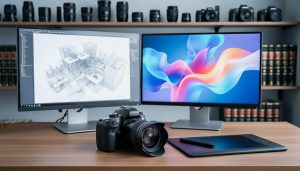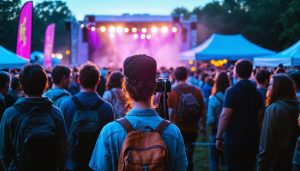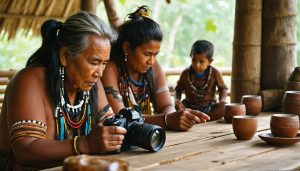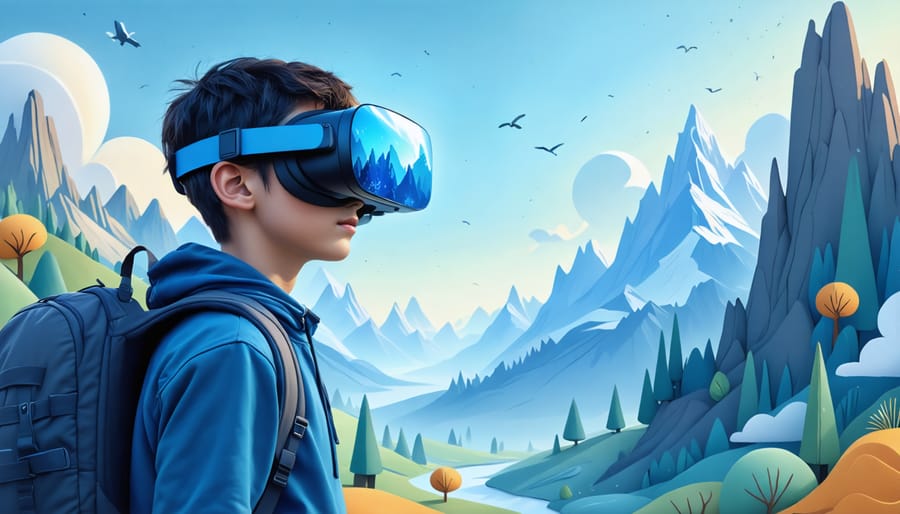
Virtual photography transcends traditional camera work, merging digital artistry with cutting-edge technology to create stunning visual experiences in virtual environments. Unlike conventional photography, this emerging discipline captures moments within digital worlds, from video game landscapes to immersive VR experiences, pushing the boundaries of visual storytelling beyond physical limitations.
Think of virtual photographers as digital explorers, wielding specialized tools to frame, compose, and capture moments that exist purely in computer-generated spaces. They manipulate virtual lighting, adjust digital camera parameters, and position themselves in impossible ways to achieve perspectives that would be physically unattainable in real-world photography.
This revolutionary approach to image-making has transformed how we document virtual worlds, from architectural visualizations to gaming memories, creating a new artistic medium that bridges the gap between traditional photography and digital art. As technology advances, virtual photography continues to evolve, offering photographers unprecedented creative freedom and opening new possibilities for visual expression in the digital age.
What Makes Virtual Photography Different
Beyond Traditional Camera Mechanics
Virtual photography in VR environments breaks free from many traditional camera constraints. Unlike conventional photography, where you’re limited by physical camera positioning and real-world physics, virtual photographers can move their viewpoint literally anywhere within the digital space. Imagine floating mid-air to capture the perfect angle or positioning yourself inside solid objects for unique perspectives – possibilities that would be impossible with traditional cameras.
The control over lighting is also revolutionarily different. While traditional photographers work with available light or complex lighting setups, virtual photographers can instantaneously adjust lighting conditions, create multiple light sources, or even bend light in ways that defy physics. Time of day, weather conditions, and atmospheric effects become creative tools rather than environmental constraints.
Moreover, virtual photography eliminates common technical limitations like depth of field restrictions or lens distortion unless deliberately chosen for artistic effect. Camera settings become more intuitive and instantaneous, allowing photographers to experiment freely without worrying about equipment damage or physical limitations. This freedom transforms the creative process, enabling photographers to focus purely on composition and storytelling.
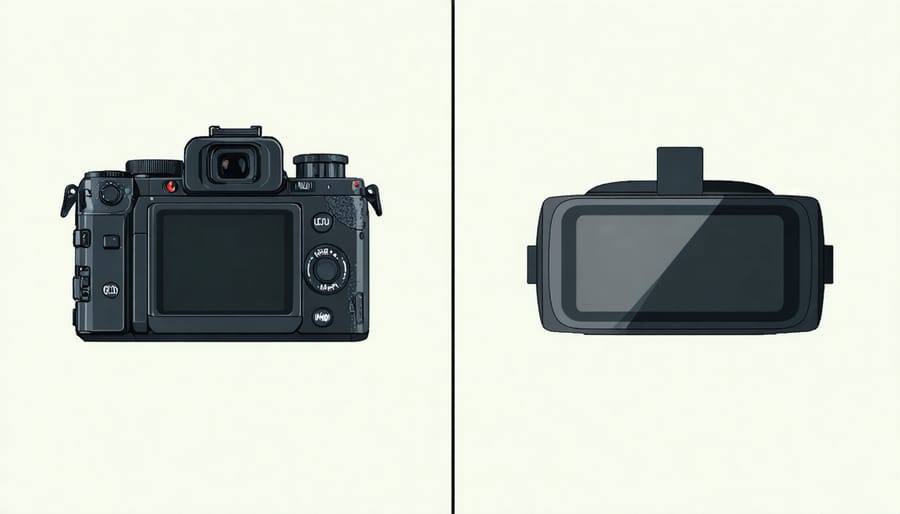
The Virtual Camera’s New Rules
Virtual photography in VR environments introduces a unique set of rules and considerations that differ significantly from traditional photography. While familiar concepts like composition and lighting still apply, photographers must adapt to new tools and perspectives. Understanding these VR camera techniques is essential for creating compelling virtual images.
In virtual spaces, photographers aren’t limited by physical constraints. You can position your camera anywhere in 3D space, even in locations that would be impossible in the real world. This freedom comes with new responsibilities – considering viewing angles from multiple perspectives and ensuring your composition works from various vantage points.
Virtual cameras also introduce unique tools like noclip modes, allowing you to move through solid objects, and custom FOV (field of view) adjustments that can dramatically alter perspective. Time control is another powerful feature, letting you pause, slow down, or reverse moments to capture the perfect shot.
Lighting in virtual environments operates differently too. While it follows similar principles to real-world photography, you often have unprecedented control over light sources, shadows, and atmospheric effects, opening up new creative possibilities that would be challenging or impossible to achieve traditionally.
Popular VR Photography Applications
Professional VR Photography Tools
In today’s professional VR photography landscape, several powerful tools have emerged as industry standards for creating immersive virtual experiences. Adobe’s Substance 3D software suite leads the pack, offering photographers comprehensive tools for texture creation, lighting simulation, and environmental design. This versatile platform enables photographers to master pro-level interaction techniques while maintaining creative control over their virtual scenes.
Unity HDRP (High Definition Render Pipeline) has become another go-to solution, particularly for photographers transitioning from traditional to virtual photography. Its physically-based rendering system ensures realistic light behavior and material properties, crucial for achieving photorealistic results in virtual environments.
For specialized 360-degree VR photography, tools like PTGui Pro and Matterport Pro2 3D Camera offer professional-grade solutions. These applications excel in stitching multiple images seamlessly and creating navigable virtual spaces with exceptional detail and clarity.
Cloud-based platforms like Nvidia Omniverse have revolutionized collaborative virtual photography, allowing multiple artists to work simultaneously on the same virtual scene. This platform’s real-time ray tracing capabilities and AI-enhanced tools have made it particularly valuable for architectural and product photography in virtual spaces.
When selecting professional VR photography tools, consider factors like rendering quality, workflow integration, and export compatibility with various VR headsets and platforms. Many of these tools offer free trials, allowing photographers to test their features before making a significant investment.
Consumer-Level VR Photo Apps
Virtual photography has become increasingly accessible thanks to user-friendly VR apps designed for consumers. Apps like Google’s Cardboard Camera and Facebook’s 360 Photo make it easy for anyone to capture and share immersive photographs using just their smartphone and a basic VR headset.
Popular apps like Momento360 and kuula allow users to capture, edit, and share 360-degree photos with minimal technical expertise. These platforms often include built-in communities where photographers can showcase their work and learn from others exploring virtual photography.
For those looking to take their first steps into VR photography, apps like VSCO VR and Insta360 Moment offer intuitive interfaces combined with powerful editing tools. These applications typically include features like exposure adjustment, color correction, and various filters specifically designed for spherical images.
Some standout features across these consumer apps include:
– One-click sharing to social media platforms
– Basic stitching tools for creating panoramas
– Virtual gallery spaces for displaying photos
– Live preview options before capturing
– Cloud storage for VR photos
– Basic editing tools optimized for 360-degree content
While these consumer-level apps may not offer the advanced features found in professional software, they serve as excellent entry points for photographers interested in exploring virtual photography. Many of these apps are free or available at minimal cost, making them perfect for experimenting with VR photography techniques before investing in more sophisticated equipment.
Creative Possibilities in Virtual Photography
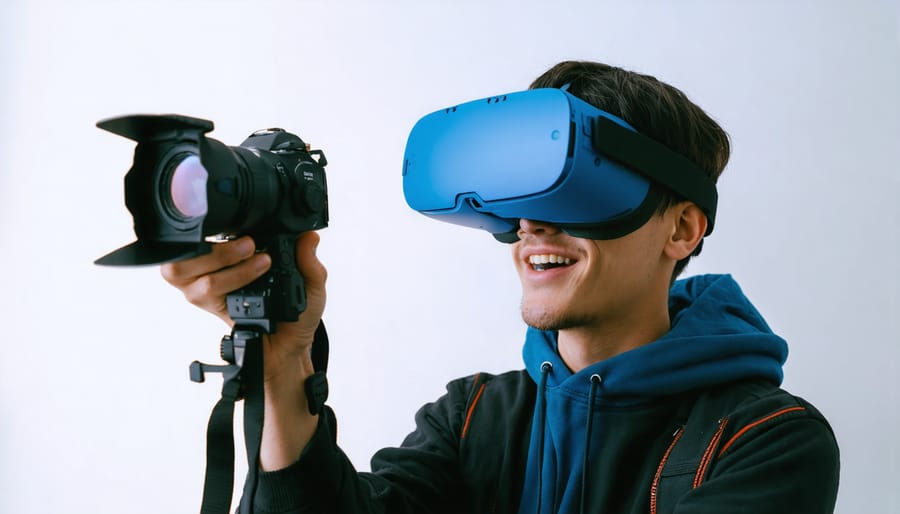
Breaking Physical Limitations
Virtual photography in VR breaks free from the physical constraints that limit traditional photographers. Imagine capturing a sunset from an impossible floating vantage point, or getting extremely close to dangerous subjects without risk. These scenarios become reality in virtual environments.
One of the most liberating aspects is the ability to defy gravity. Photographers can position themselves anywhere in three-dimensional space, whether that’s hovering above a cityscape or capturing action shots from angles that would be physically impossible in the real world. There’s no need for drones, cranes, or specialized equipment – just pure creative freedom.
Virtual environments also eliminate practical limitations like weather conditions, lighting restrictions, and location access. Want to photograph a storm while standing in its eye? Or capture the perfect golden hour lighting at any time of day? In VR, these scenarios are just a few clicks away.
Scale becomes completely flexible in virtual photography. You can shrink yourself to capture macro-level details of virtual objects or expand your perspective to photograph vast landscapes from previously unimaginable viewpoints. This flexibility extends to timing as well – virtual photographers can freeze moments perfectly or manipulate time to capture precisely the right instant.
Safety barriers disappear too. Whether it’s photographing wildlife up close, capturing extreme sports from the middle of the action, or documenting dangerous environments, virtual photography removes physical risk while maintaining creative possibilities.
Interactive Photography Experiences
Virtual photography in VR takes interactivity to unprecedented levels, transforming how we capture and experience moments. Unlike traditional photography, where viewers passively observe images, VR photography allows them to step into the scene and actively engage with their surroundings.
Imagine walking through a virtual art gallery where every photograph is a portal you can enter. You can move around within the captured space, examine details from different angles, and even interact with elements in the scene. These interactive experiences are enhanced by AI-enhanced VR photography features that respond to your movements and choices.
Modern VR photography platforms offer various interaction levels, from basic 360-degree viewing to fully immersive experiences with hotspots and clickable elements. Photographers can embed information points, audio narratives, or even mini-games within their virtual photographs, creating multi-layered storytelling opportunities.
Real estate photographers, for instance, use interactive elements to highlight property features, allowing potential buyers to tap on specific areas to reveal detailed information or measurements. Educational photographers create virtual field trips where students can interact with historical sites or scientific phenomena, making learning more engaging and memorable.
The technology also enables social interactions, where multiple users can simultaneously explore the same virtual photograph, pointing out details to each other and sharing their perspectives in real-time, creating a truly collaborative viewing experience.
Technical Requirements and Considerations
VR Hardware Essentials
To get started with virtual photography in VR, you’ll need some essential hardware components. At the core of your setup is a VR headset, with popular options including the Meta Quest 2, Valve Index, or HP Reverb G2. These headsets offer different levels of image quality and field of view, which directly impact your virtual photography experience.
Motion controllers are equally important, as they serve as your virtual camera controls. Most VR headsets come with a pair of controllers, but some photographers prefer specialized VR camera peripherals for more precise control over their virtual shots.
A powerful gaming PC is crucial for running VR photography applications smoothly. Look for a system with at least 16GB RAM, a dedicated graphics card (NVIDIA RTX 3060 or better), and a current-generation processor. This ensures your virtual environments render clearly and consistently, essential for capturing high-quality images.
Consider your physical space requirements too. While some virtual photography can be done sitting down, having a dedicated play area of at least 6.5 x 6.5 feet (2 x 2 meters) gives you the freedom to move around your subject and find the perfect angle. Good lighting in your physical space helps the VR headset’s tracking systems work optimally.
Additional accessories that can enhance your virtual photography experience include:
– VR headset comfort modifications
– External battery packs for extended sessions
– A dedicated VR cable management system
– Anti-fatigue mat for longer shooting sessions
Remember, while this might seem like a significant investment, many of these components serve multiple purposes in VR beyond just photography.
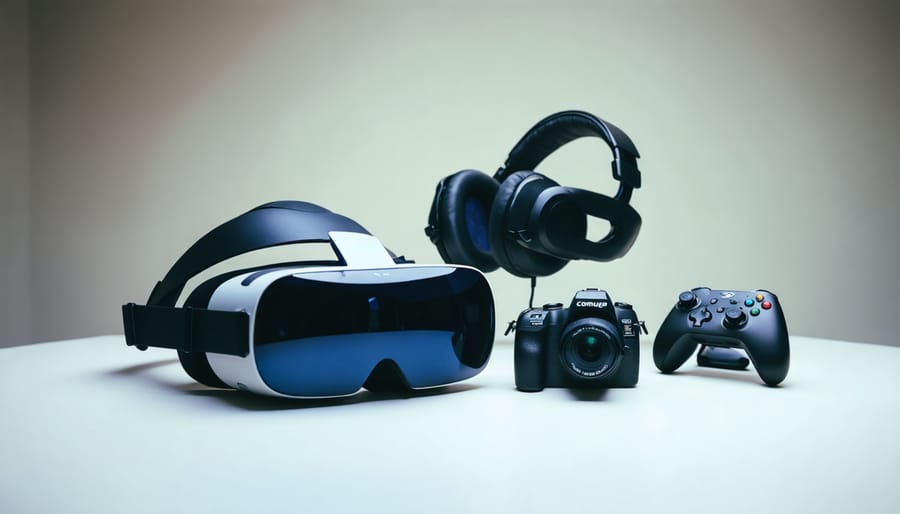
Software and Processing Power
Virtual photography requires a combination of specialized software and adequate computing power to create and process immersive images. At its core, you’ll need a robust 3D modeling or gaming engine, with popular choices including Unreal Engine, Unity, or specialized virtual photography tools like NVIDIA Ansel. These platforms serve as your virtual camera and studio environment.
Your computer’s specifications play a crucial role in the quality and efficiency of your virtual photography workflow. At minimum, you’ll want a modern multi-core processor (such as an Intel i5/i7 or AMD Ryzen 5/7), 16GB of RAM, and a dedicated graphics card with at least 6GB of VRAM. For professional work, consider upgrading to 32GB of RAM and a higher-end graphics card like the NVIDIA RTX series, which offers advanced features like ray tracing for more realistic lighting.
Post-processing software is equally important. While traditional photo editing programs like Adobe Photoshop and Lightroom can handle virtual photography outputs, specialized tools like ReShade or GeForce Experience offer features specifically designed for virtual photography, including advanced depth-of-field controls and custom filtering options.
Storage considerations shouldn’t be overlooked either. Virtual photography files, especially those captured in high resolution or with multiple post-processing layers, can quickly consume space. A fast SSD with at least 500GB of free space is recommended for smooth workflow and file management.
Remember that these requirements may vary depending on the complexity of your virtual environments and the level of detail you’re aiming to achieve. Starting with mid-range hardware and upgrading as needed is often a practical approach for beginners.
Virtual photography stands at the cusp of a revolutionary transformation in how we capture, create, and experience images. As VR technology continues to evolve, we’re witnessing the emergence of entirely new forms of visual storytelling that blur the lines between traditional photography and digital art. The impact of virtual photography extends far beyond gaming and entertainment, reaching into fields like architecture, education, and historical preservation.
The future possibilities are particularly exciting. We’re already seeing the development of more sophisticated VR cameras, advanced rendering technologies, and innovative ways to share virtual photographs across different platforms. As these tools become more accessible and user-friendly, we can expect to see a surge in creative expression from both professional photographers and enthusiasts alike.
The democratization of virtual photography tools means that anyone with a passion for visual storytelling can now explore previously impossible perspectives and compositions. This accessibility is fostering a new generation of digital artists who combine traditional photographic principles with virtual world capabilities.
Looking ahead, we can anticipate even more seamless integration between real and virtual photography, with mixed reality experiences becoming commonplace. The potential for virtual photography to revolutionize how we document, share, and experience moments is boundless, making it an exciting time for anyone interested in the future of visual media.

